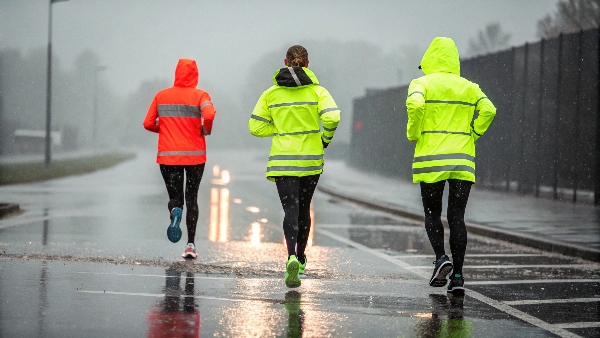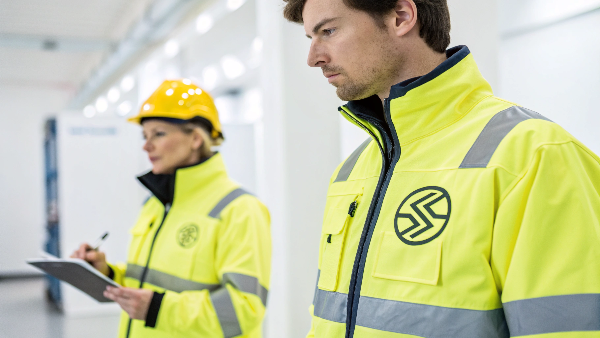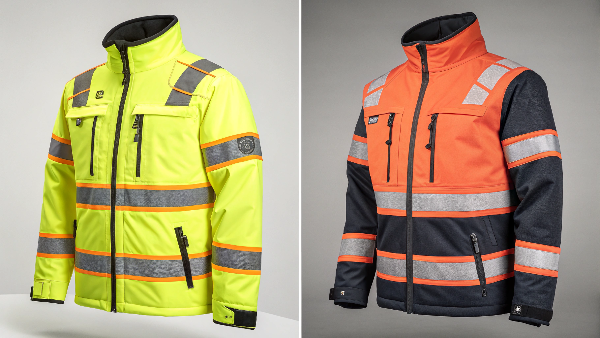Summer heat is a big problem. Construction work must continue. So, how do workers stay safe and comfortable?
Construction workers often wear high-visibility, long-sleeved shirts and durable pants. These items protect from sun and injury. Some special fabrics also help keep them cool. Cooling vests are another option workers use when it gets very hot.
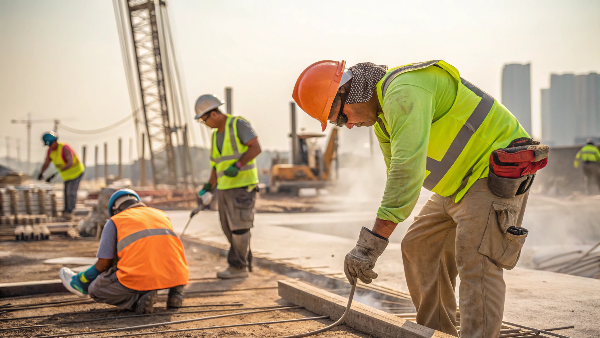
It might seem strange to wear long sleeves and pants when it's hot. But there are very good reasons for this choice. We, at Vissafety, have spent years perfecting workwear for all conditions. Let's look deeper into how construction workers handle the summer heat and why their clothing choices are so important. Understanding this helps us provide the best gear.
How do construction workers stay cool in the summer?
Overheating on a construction site is a serious danger. But work needs to get done on schedule. So, what are the best ways for workers to stay cool?
Workers stay cool by wearing special breathable, moisture-wicking fabrics1. They also use cooling vests2. Taking breaks in shaded areas and drinking plenty of water are also key. The right clothing choice makes a big difference.
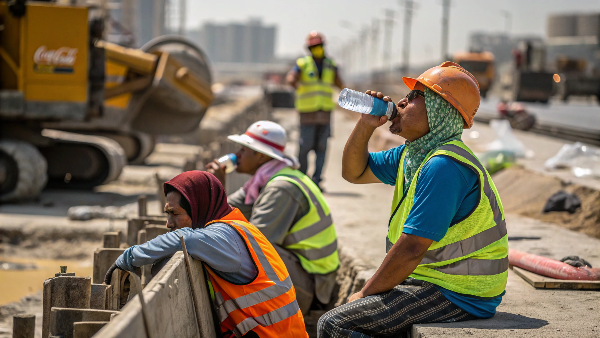
Staying cool is not just about comfort; it's about safety. When I talk to site managers, they always stress the importance of preventing heat stress3. The first line of defense is the clothing. Modern fabrics are amazing. We use materials that pull sweat away from the skin. This helps the body cool itself naturally. These are often lightweight but still very durable. Another popular option we supply are cooling vests. These vests can be soaked in water or have special cooling packs. They provide direct cooling to the body's core. But clothing is just one part. Workers must also take regular breaks in the shade. And they need to drink water constantly, even before they feel thirsty. It's a combination of good gear and good habits.
| Cooling Strategy | Description | Why it Works |
|---|---|---|
| Breathable Clothing | Lightweight, moisture-wicking fabrics (like those Vissafety uses). | Allows sweat to evaporate, cooling the skin. |
| Cooling Vests | Vests that use water evaporation or cooling packs. | Directly lowers core body temperature. |
| Hydration | Drinking water or electrolyte drinks regularly. | Replaces fluids lost through sweat. |
| Shade & Breaks | Taking frequent breaks in cool, shaded areas. | Allows the body to recover from heat exposure. |
| Light Colors | Wearing lighter-colored clothing. | Reflects sunlight rather than absorbing it. |
Why do construction workers wear hoodies in the summer?
Seeing workers in hoodies during hot summer months can look strange. It appears like it would be too warm. But there is often a practical reason for this choice.
Some construction workers wear lightweight, light-colored hoodies mainly for sun protection4. These hoodies can cover the neck and ears. They can also offer some sweat absorption and shield from dust.

I've seen this on many sites, especially with workers who are out in direct sun all day. A lightweight hoodie isn't like a heavy winter one. The key is the material. Many are made from thin, breathable fabrics, sometimes with a UPF rating for sun protection. The hood can be pulled up to protect the neck and ears. These areas are very sensitive to sunburn. A client once mentioned his crew preferred them on very dusty sites too. The hoodie helped keep some of the fine particles off their head and neck. Of course, it's a personal preference for some. But for others, it’s a smart way to get extra protection without wearing a separate hat or neck cover. We've even seen requests for custom high-visibility hoodies5 made from summer-weight materials.
| Hoodie Use in Summer | Pro | Con |
|---|---|---|
| Sun Protection | Covers neck, ears, and part of the face. | Can feel warmer if not breathable. |
| Dust Shield | Offers a barrier against dust/debris. | May not be needed in all environments. |
| Sweat Absorption | Can absorb sweat from head and neck. | Can become damp and heavy if not wicked. |
| Comfort | Some workers find them comfortable. | Others may find them too enclosing. |
Do construction workers work in hot weather?
Extreme heat makes any physical work very tough. But construction projects often have tight deadlines. So, does work stop when the temperature gets very high?
Yes, construction work often continues even in hot weather. However, companies must put safety measures in place. These include adjusted work schedules, mandatory breaks6, and providing plenty of water to protect workers from heat illness.
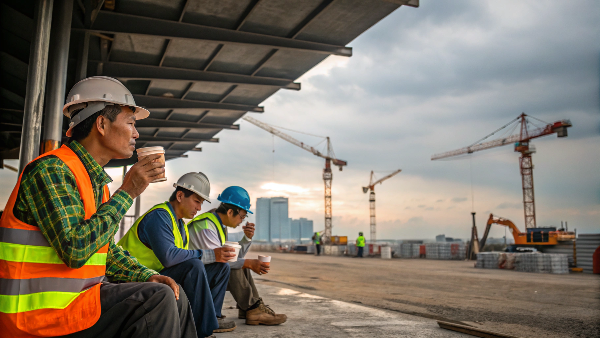
Construction projects usually have to stick to a schedule. So, stopping work completely for heat is rare, unless conditions are extreme and dangerous. What usually happens is that companies adapt. I know from our clients that they take heat safety7 very seriously. They might start the workday earlier, before the sun is at its peak. Or they might schedule more frequent, shorter breaks in cool areas. Providing ample water is a basic requirement. Some companies also train workers to recognize the signs of heat stress in themselves and their colleagues. As a supplier, we at Vissafety understand this. We ensure our summer-weight safety gear, like high-visibility shirts, offers good airflow and helps manage sweat. The goal is to allow work to continue safely. It’s about managing the risk.
| Heat Safety Measure | How it Helps | Responsibility |
|---|---|---|
| Adjusted Schedules | Work during cooler parts of the day. | Employer |
| Mandatory Breaks | Allows body to cool down regularly. | Employer |
| Water & Electrolytes | Prevents dehydration and heat cramps. | Employer (to provide) |
| Acclimatization | Gradually getting used to working in heat. | Employer (phased work) |
| Appropriate PPE | Breathable, light-colored, hi-vis clothing. | Employer (to provide/ensure) |
| Training | Recognizing heat illness symptoms. | Employer |
How to beat the heat as a construction worker?
The summer sun can be relentless on a construction site. Staying productive and safe is a real challenge. So, what practical steps can workers take to manage the heat?
Workers can beat the heat by wearing light-colored, loose-fitting, and breathable clothing8. They need to hydrate frequently. Taking breaks in the shade is essential. Using cooling accessories9 like neck gaiters or cooling vests also helps a lot.
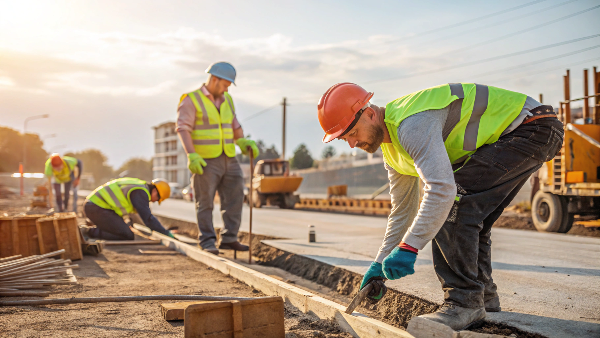
I've learned a lot from talking to workers and safety officers over the years. The first thing they always mention is clothing. Light colors reflect heat. Loose fits allow air to circulate. And breathable, moisture-wicking fabrics, like the ones we focus on at Vissafety, are critical. These fabrics pull sweat away from the skin, which is how your body cools itself. Next is hydration. Drink water often, not just when you feel thirsty. Sports drinks can help replace electrolytes lost through sweat on very hot days. Regular breaks in a cool, shaded spot are non-negotiable. Even 10-15 minutes can make a difference. Some workers also use personal cooling items. These can be wet towels, cooling neck gaiters, or even specialized cooling vests that we can supply. It's about a total approach to managing your body's temperature.
| Heat Beating Tip | Action | Benefit |
|---|---|---|
| Proper Clothing | Wear light, loose, breathable, UPF-rated hi-vis gear. | Reduces heat absorption, promotes cooling. |
| Consistent Hydration | Drink water or electrolyte drinks every 15-20 minutes. | Prevents dehydration, maintains performance. |
| Scheduled Breaks | Take regular breaks in shade or a cool environment. | Allows body to cool down and recover. |
| Cooling Accessories | Use cooling towels, neck wraps, or cooling vests. | Provides direct cooling relief. |
| Pace Yourself | Adjust work intensity based on heat and personal tolerance. | Reduces risk of overexertion and heat illness. |
| Buddy System | Watch out for coworkers and be aware of heat illness signs. | Ensures quick response if someone is affected. |
What color shirt do construction workers wear?
The color of a worker's shirt might seem like a small detail. But on a busy construction site, it really matters for safety. So, what colors are typically chosen and why?
Construction workers usually wear fluorescent colors like yellow-green or orange for their shirts and vests. These high-visibility colors, often combined with reflective tape, make them easily seen by equipment operators and drivers, which greatly enhances their safety.

This is a core part of what we do at Vissafety. High-visibility clothing is essential. The most common colors are fluorescent yellow-green and fluorescent orange. Sometimes red is also used, though it's less common for general site work. These colors are chosen because they contrast strongly with most backgrounds found on a construction site. This makes workers stand out, especially during the day. For work in low light or at night, these garments must also have retroreflective tape. This tape reflects light back towards the source, like headlights. Standards like ANSI/ISEA 107 in the US and EN ISO 20471 in Europe specify these color and reflectivity requirements. We ensure all our hi-vis garments meet these strict standards. It's not just about looking bright; it's about being seen to prevent accidents.
| Hi-Vis Color | Primary Benefit | Common Standard Reference |
|---|---|---|
| Fluorescent Yellow-Green | Highest visibility in daylight, good contrast. | ANSI/ISEA 107, EN ISO 20471 |
| Fluorescent Orange-Red | Excellent visibility, especially against green/blue backgrounds (e.g., foliage, sky). | ANSI/ISEA 107, EN ISO 20471 |
| Fluorescent Red | Good visibility, often used for specific roles or in combination. | ANSI/ISEA 107, EN ISO 20471 |
Why do construction workers wear jeans?
Jeans are a common sight in everyday life. They might seem too hot and heavy for summer construction work. So, why are they still a popular choice for many workers on site?
Many construction workers wear jeans for their durability and the protection they offer against cuts, scrapes, and sometimes even sparks. While traditional heavy denim can be hot, some workers opt for lighter-weight work pants that offer similar protection with better breathability.
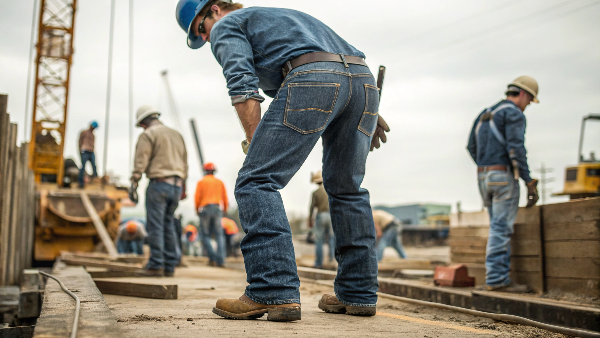
I've seen jeans on job sites for as long as I've been in this business. The main reason is toughness. Denim is a strong fabric. It can withstand a lot of wear and tear. It offers a decent barrier against minor cuts from tools or scrapes from rough materials. Some types of work, like welding, might see workers using even heavier denim for spark resistance. However, standard jeans are not always the best for very hot weather. They can be heavy and don't always breathe well. That's why we at Vissafety have developed work trousers made from advanced, durable fabrics. These fabrics are often lighter than denim but still provide excellent abrasion resistance. Plus, they can incorporate features like moisture-wicking and better ventilation. So, while jeans have their place, there are often more specialized and comfortable options available now.
| Feature | Traditional Jeans | Modern Work Pants (e.g., Vissafety options) |
|---|---|---|
| Durability | Good to Excellent | Excellent, often with reinforced areas |
| Protection | Decent against scrapes, some impact | Can offer similar or better, plus specialized protection |
| Breathability | Low to Moderate | Moderate to High (material dependent) |
| Moisture Wicking | Poor | Often Good to Excellent |
| Weight | Can be heavy | Often Lighter |
| Flexibility | Can be restrictive | Often designed with gussets for movement |
| Hi-Vis Options | Not standard (requires added elements) | Often available as hi-vis standard |
Does OSHA say you can't wear shorts?
Shorts seem like a logical choice for staying cool in summer. But construction sites have many safety rules. So, what is OSHA's official stance on workers wearing shorts?
OSHA, the Occupational Safety and Health Administration, doesn't have a specific rule that bans shorts. However, employers are required to assess workplace hazards. If there's a risk of leg injury (like cuts, burns, or chemical splashes) then shorts would not provide adequate protection, and long pants would be necessary.

This is a common question. OSHA's rules focus on employers providing appropriate Personal Protective Equipment (PPE) based on job hazards. There isn't a blanket "no shorts" rule. The key is the hazard assessment. If a worker is, for example, doing tasks where their legs are exposed to sharp objects, hot materials, or chemicals, then shorts are not suitable. Long pants would be required to protect their legs. I recall a safety manager explaining that for his road crew flaggers, who were mainly exposed to sun and heat, shorts might be permissible if other risks were low. But for welders or concrete workers, long pants are essential. We at Vissafety always recommend erring on the side of caution. We provide a wide range of durable, protective long pants, including summer-weight options that offer both protection and better comfort in the heat.
| Consideration | Shorts | Long Pants |
|---|---|---|
| Sun Protection | None for lower legs | Good for lower legs |
| Injury from Debris | High risk of cuts, scrapes | Offers a barrier against minor impacts/cuts |
| Chemicals/Burns | No protection | Provides a layer of protection |
| Insect/Plant Irritants | Exposed skin | Protects skin |
| OSHA Compliance | Permissible if no leg hazards are identified | Generally required if leg hazards exist |
| Comfort in Heat | Can be cooler | Can be hotter, unless made of breathable fabric |
How to dress for construction in the summer?
Summer construction work is very demanding. Dressing correctly is not just about comfort; it's vital for safety and health. So, what's the best overall strategy for summer workwear?
Dress in layers if morning temperatures are cool but expect a hot day. Choose light-colored, loose-fitting, breathable, high-visibility clothing. Long sleeves and pants are often best for sun and injury protection. Don't forget a wide-brimmed hat and safety glasses.
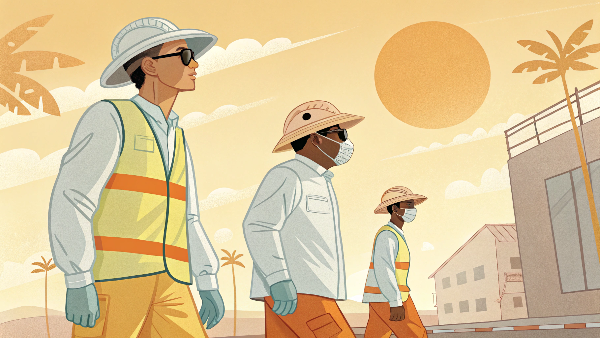
Putting it all together, dressing for summer construction involves several key elements. As a manufacturer, we at Vissafety focus on these. First, high-visibility is crucial. This means fluorescent colors and reflective tape, meeting standards like ANSI/ISEA 107. Second, the fabric should be breathable and moisture-wicking to help manage heat and sweat. Light colors are better than dark ones as they reflect sunlight. While it sounds counterintuitive in heat, long sleeves and long pants offer superior protection from UV radiation and common site hazards like scrapes or contact with irritants. We produce many lightweight long-sleeve shirts and pants for this reason. A wide-brimmed hat is essential to protect the face, ears, and neck from the sun. And, of course, safety glasses are a must. Some workers might also benefit from cooling vests or other cooling accessories if the heat is extreme. It’s about creating a complete system for safety and relative comfort.
| Clothing Item | Key Features for Summer Construction | Why It's Important |
|---|---|---|
| Shirts | High-visibility, long-sleeved, breathable, moisture-wicking, UPF-rated. | Visibility, sun protection, cooling, comfort. |
| Pants | Durable, breathable, possibly hi-vis, full-length. | Protection from injury/sun, durability, some hi-vis needs. |
| Vests | High-visibility (if worn over non-hi-vis shirt), cooling vests. | Enhanced visibility, added cooling. |
| Headwear | Wide-brimmed hat, hard hat with sunshade. | Sun protection for head, face, neck. |
| Eyewear | Safety glasses with UV protection, possibly tinted. | Eye protection from debris and UV rays. |
| Footwear | Sturdy work boots with good support and protection. | Foot protection, stability. |
| Accessories | Cooling towels, neck gaiters. | Additional personal cooling. |
Conclusion
Dressing right for summer construction is vital. It keeps workers safe from accidents and protects them from the heat. Choose breathable, protective, high-visibility gear for best results.
-
Explore this link to understand how breathable fabrics can enhance comfort and safety for construction workers in hot weather. ↩
-
Learn about cooling vests and how they can effectively lower body temperature for workers in high heat environments. ↩
-
Discover essential strategies to prevent heat stress, ensuring safety and productivity on construction sites during summer. ↩
-
Explore this link to understand how sun protection clothing can safeguard workers from harmful UV rays, enhancing their safety on the job. ↩
-
Learn about the importance of high-visibility hoodies in construction for safety and visibility, especially in hazardous environments. ↩
-
Understanding the importance of mandatory breaks can help ensure worker safety and productivity in extreme heat conditions. ↩
-
Explore this link to learn about essential heat safety measures that can protect construction workers from heat-related illnesses. ↩
-
Explore how breathable clothing can enhance comfort and safety for construction workers in extreme heat. ↩
-
Discover various cooling accessories that can help construction workers stay cool and safe on the job site. ↩

